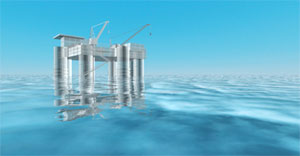Aerospace manufacturer Lockheed Martin is looking under the ocean to develop ocean thermal renewable energy, a technology we rarely hear about, but which has strong potential.
Apparently, Lockheed has quietly been working on this technology for decades and will now develop a pilot off the coast of southern China.
They signed an agreement with Beijing-based Reignwood Group, which produces "Red Bull," to build a 10 megawatt (MW) plant that powers their eco-resort, which is under development. It is planned to be a net-zero energy community.
Reignwood is developing two large eco-resorts and has plans for others on the China’s coast. After this pilot plant is operating – the largest ocean thermal project to date – the companies say they will improve the design and then build additional plants ranging
in size from 10-100 MW.
A commercial-scale plant would be able to power a small city.
"The benefits to generating power with OTEC are immense," says Dan Heller, vice president of new ventures for Lockheed Martin Mission Systems and Training. "Constructing a sea-based, multi-megawatt pilot OTEC power plant for Reignwood Group is the final step in making it an economic option to meet growing needs for clean, reliable energy."
Ocean Thermal Energy Conversion (OTEC) leverages the ocean’s natural thermal gradient to generate power.

Lockheed explains:
In geographical areas with warm surface water and cold deep water, the temperature difference can be leveraged to drive a steam cycle that turns a turbine and produces power. Warm surface sea water passes through a heat exchanger, vaporizing a low boiling point working fluid to drive a turbine generator, producing electricity.
The system can also include fresh-water production by flash evaporating the warm sea water and condensing the subsequent water vapor using cold sea water.
And the process can provide baseload power, rather than intermittent energy, available 24 hours a day, seven days a week.
The concept of ocean thermal dates back to the 1880s and a demonstration plant was built in 1930.
In the 1970s, Lockheed developed a mini-plant, which ran for three months, successfully generating 50 kilowatts of electricity.
Since 2009, the U.S. Naval Facilities Engineering Command has awarded Lockheed Martin $12.5 million to develop critical OTEC system components and advance the design for an OTEC pilot plant, an essential step in developing large-scale utility plants.
